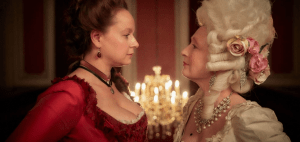Recently, I started watching a¬†new British drama called Harlots. Harlots explores the rivalry between two different brothels in 18th century London. Margaret Wells runs one of the brothels, with Lydia Quigley running the other. If the brightly colored promotional photos weren’t enough to catch my attention, the stunningly relatable women it highlights are. Although sex is an inherent element of the storyline, no episode yet has exhibited the omnipresent male gaze. Rather, the shenanigans that these ladies get into and the hardships they face drive the storyline onwards. It’s not surprising that the male gaze is lacking, however; the show is written, directed, and produced by women.
Admittedly, Harlots was an intimidating show to start watching given its proposed subject matter. I was surprised when the show reflected contemporary female relationships in both brothels. It also depicts significant issues that modern girls face. For example, the show explores the struggles of living in the lowest social strata with little autonomy and wealth to one’s name. These heavy subjects are balanced by everyday problems like falling in love.
Thus far, the show has been progressive without feeling exclusive. It features two main interracial couples and one burgeoning lesbian romance. By showing these relationships as normal, Harlots can reach different types of girls everywhere, and portray many types of relationships as natural and normal. It also gives voice to situations that girls face that are not often discussed. For instance, Harlots shows Lucy Wells’s first sexual encounter. The show then explores how this encounter impacts Lucy’s future sexual interactions. Modern girls discuss and imagine their “first” in endless detail before it happens, but say very little about the actual experience afterwards, as it so rarely matches the imagined hopes and expectations.
Additionally, Charlotte Wells’s protectiveness of her younger sister Lucy places family at the forefront of the show. In fact, it almost reflects my own relationship with my sister too much. Margaret Wells’s loving admonishment rings with tones mirroring my mother’s own. I found myself thrown back to moments of my own girlhood as Margaret chastised her daughters. Family, friendship, and strong females are at the center of this story. I encourage everyone to try out the show for themselves and see if you can relate to these girls as much as I have.
Hope you enjoy!
-Megan Cooper
Junior Girl
Girl Museum Inc.

